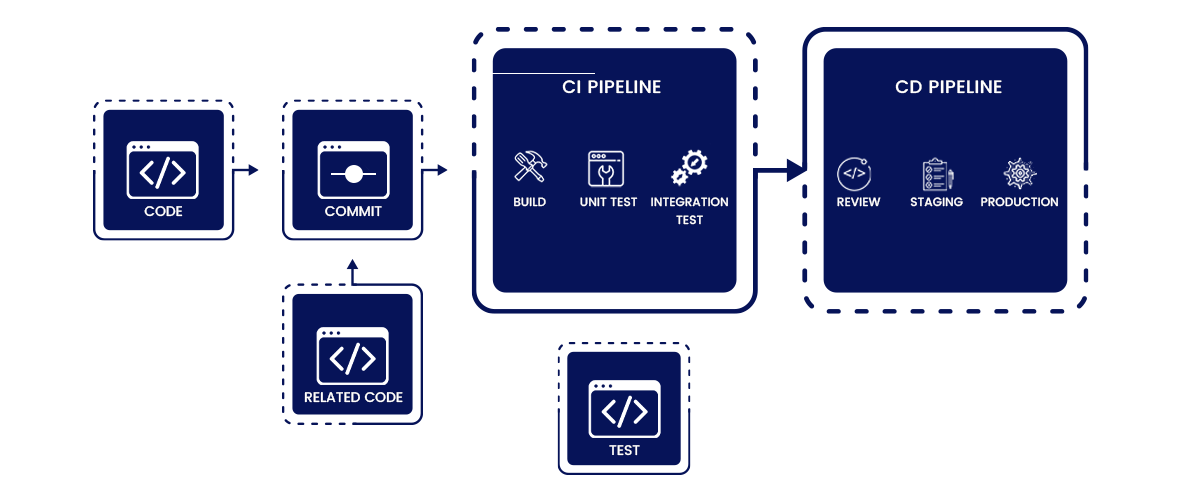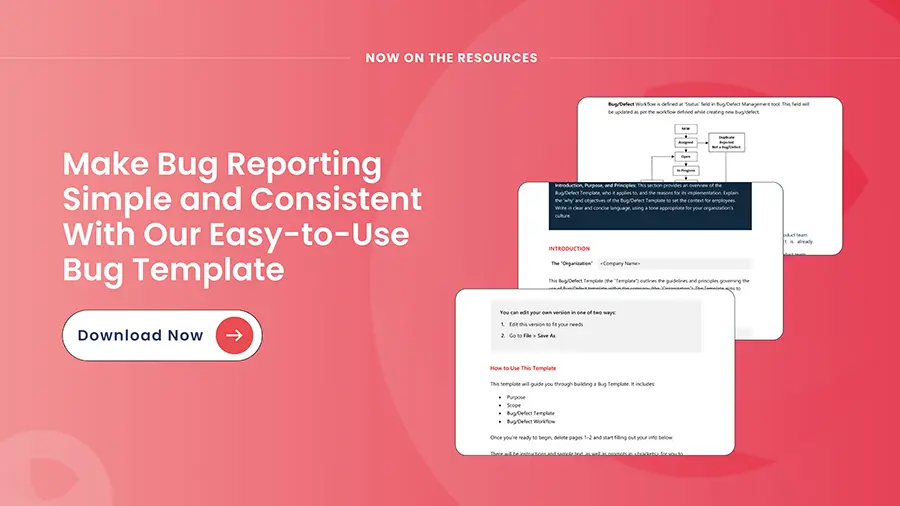Businesses are leveraging DevOps, Agile, Low-Code – No-Code platforms, and AI-ML solutions to achieve scalability of software operations and business efficiency. Continuous Integration and Continuous Delivery, in particular, have been key enablers for software development teams in managing software operations and bringing in more cohesiveness in the whole function.
One of the main reasons behind the success of CI-CD is focusing on Automation. Focusing on test automation builds faster feedback loops, detecting defects and errors at an early stage in the development lifecycle. Advanced and AI-based test automation tools ensure that codes entering the live environments are thoroughly tested and running as expected.
CI-CD pipelines offer more opportunities to run more tests and increase test coverage without halting the ongoing development work. As the repetitive tests are automated, testers get more time to write new test cases, work on test data, and test applications more thoroughly. Let’s talk about why CI-CD is important for software development teams and what role Automated Testing plays in CI-CD.
What is DevOps?
DevOps is the working style or culture or philosophy that focused on bringing a cultural shift to deliver applications and services at a faster rate with better quality. It emphasizes bringing two siloed functions – Development and Operations together to bring transparency, collaboration, and coordination to better serve customers.
What is CI-CD in DevOps?
Continuous Integration involves build and unit testing stages in the software development process. Every new piece of code must trigger a series of automated tests and pass through the same to be merged into live environments.
Continuous Deployment or Continuous Delivery ensures that the entire software release process from code merge to automated tests and rolling of infrastructure is automated (as much as possible). This helps in keeping the entire codebase always ready for deployment.
Continuous integration and continuous deployment involve a series of processes in making any piece of code live or deployed in live environments. This series of processes is often referred to as the CI-CD pipeline. Pipelines involve automated tools, processes, and frameworks that focus on deploying codes fast with utmost quality, without breaking the previous functionalities.
CI-CD tightly integrates the development, testing, production, and monitoring phases of the software development lifecycle. With the right amount of automation and tools for collaboration, CI-CD pipelines make it possible for teams to release high-quality code faster. The true value of CI-CD pipelines is realized through automation.

What are the top 5 benefits of CI-CD Pipelines?
Implementing CI-CD pipelines and mastering them requires continuous efforts, time, and resources but the benefits outweigh them. Let’s look at the top five benefits of implementing a CI-CD pipeline for businesses –
- Faster Deliveries – With customer expectations rising every minute, it becomes very critical for an organization to stay on top of its digital game. CI-CD pipelines help in rolling out new software every week or even on daily basis. This could not have been imagined with traditional waterfall methods.
In an iterative exercise like Software Engineering, where there are multiple teams, processes, tests, and frameworks involved, CI-CD builds a unified developing and deploying experience for developers. Without any human intervention in terms of testing, infrastructure, and external coordination, CI-CD enables faster delivery. - Better Code Quality – Kent Beck, creator of extreme programming, says “Make it right, make it fast, make it work”. Organizations are looking to achieve this without compromising on code quality. Mature CI-CD pipelines with integrated testing improve code quality by automating testing across the development process.
Developing your software using CI/CD ensures that code is tested rigorously at each stage to detect bugs faster and remove them in the initial phases. Removing bugs combines writing quality code, identifying and automating the right test cases, monitoring the complete pipeline, and generating extensive reports to find out errors and their locations. This helps in limiting the scope of fault code entering the live environments. - Infrastructure Availability and Optimization – We all have heard these phrases from our developer friends, “I don’t have access to this environment”, “It was running fine in the pre-prod”, and “I need to first request the Ops team to roll out new infra”.
Automation is the holy grail of the CI-CD pipeline, thus making the infrastructure and operations reliable and repeatable. The infrastructure-as-code approach involves the automatic creation of the environment via pre-defined templates using version control tools. This means new infrastructure can be spun up and down based on requirements and with limited dependencies on infrastructure engineers. This makes development and delivery faster and more reliable. - Measuring and Monitoring – Software development has its ups and downs. The data generated at every stage can give insights to make the whole process more efficient, agile, and adaptable. A well-established CI-CD pipeline helps in gathering all data in tools and analyzing them for more predictable errors and solutions.
CI-CD pipelines ensures a multi-layered approach that captures data from various stages right from planning to production. This helps software teams in being proactive rather than reactive for future incidents. Over a period, these insights are used to train AI models and build systems that are self-sufficient in terms of patching, recovery, and handling the first line of bugs. Continuous monitoring also gives industry and team benchmarks to continuously work towards improving the process. - Reduced Manual Efforts – As we said earlier, automation is the holy grail of CI-CD pipelines. This means putting shift-left in practice using automation from the start. With shift-left practice, the test suite is automatically triggered so that the code doesn’t break and new features are pushed after complete testing.
The automation reduces the manual effort that goes into testing with each and every build and ensures that manual efforts for repetitive tasks are reduced.
What is Automated Testing?
Automated Testing is the software testing process where manual efforts are reduced using test automation tools and frameworks to execute test cases in a continuous fashion across the software development lifecycle. Everything you need to know about Test Automation.
How to achieve Automated Testing in CI-CD?
Achieving effective automated testing in a CI/CD context is a journey. Below are key steps and considerations:
Select the right tools and frameworks: Make sure your stack integrates seamlessly with your CI/CD system (e.g., Jenkins, Azure DevOps, GitLab CI, GitHub Actions).
Embed tests into the pipeline: Every new build should trigger an automation suite. Unit tests → integration tests → UI/API tests → performance/security tests, based on the pipeline stage.
Define test data & environments: Manage test data, environment setup, test isolation. Leverage containerisation (e.g., Docker), test orchestration and parallel execution for speed and consistency.
Run in parallel & optimise execution time: Use parallel test execution and cloud-based infrastructure to reduce time to feedback.
Test types beyond just Functional: Cover API, UI, performance, security, compliance.
Maintain & monitor the suite: Automation suites need maintenance. Flaky tests, obsolete tests, changing requirements—all need continuous attention.
Reskill testers: Automation doesn’t replace testers—it changes their role. Testers focus on automation strategy, analytics of results, exploratory testing and validating what machines cannot.
Integrate with DevOps culture: Test automation, deployment automation, infrastructure automation—all need to be part of a culture of “quality everywhere”.
Feedback & metrics: Use dashboarding, metrics like build time, test coverage, deployment frequency, change-failure rate. Use insights to improve continuously.

Is automated testing end of manual testing?
It is commonly believed that automated testing will eradicate the need for manual and professional testers. This is entirely false as the need for resources is likely to go up with automation taking up the repetitive and manual tasks. There’s an innate need for reskilling and upskilling the manual testers to learn new tools, explore more ways of testing, work alongside automation and AI-ML systems, and improve their interpersonal and soft skills.
Automated testing helps in using engineers explore and develop new ways of testing and do end-to-end exploratory testing. Testers can use their logic and reasoning thinking to find flaws in the application that automated tests cannot find.
Also, using human intellect in security testing can help companies in saving thousands of dollars in breaches. While a program would only be able to identify what it is written for, the human conscience is capable of seeing irregular patterns leading to better security posture.
How Automated Testing Enhances CI/CD: The Mechanisms
Here’s how the mechanisms work in practice:
Faster feedback loops: Automated tests triggered on every commit ensure defects are caught early, before they propagate.
Improved code quality: With unit, integration, UI, API, performance & security tests running systematically, the barrier for low-quality code reaching production rises.
Higher test coverage without slowing development: Because tests are automated and integrated, more scenarios (including non-functional) can be added without halting development.
Better utilisation of tester resources: With repetitive test execution automated, testers can focus on new test design, exploratory testing, test data strategy and deeper quality work.
Infrastructure and environment reliability: Test environments are spun up, torn down, managed as code—eliminating “works on my machine” issues and making CI/CD more predictable.
Data-driven improvement: Test execution data, build metrics, flakiness reports feed into continuous improvement, helping refine the pipeline, fastest failing tests, fastest fixes.
Risk management: By automating regression, performance, security and compliance checks, organisations reduce the risk of production defects, breaches or downtime.
Conclusion
Automated testing holds the key to a robust CI-CD pipeline.
What compounds this scenario is the evolving application and software development landscape. It is no longer sufficient to think about automated testing as a bolt-on capability. It must be ubiquitous and integrated with the CI-CD technology stage from day zero.
If you are looking to enhance your CI-CD pipeline with automated testing, let’s talk marketing@enhops.com.




